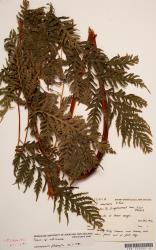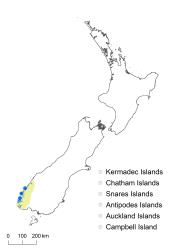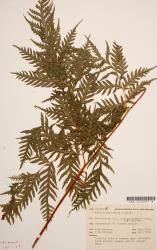In New Zealand, Pteris epaleata is known only from three incomplete collections with fronds up to 1250 mm long. Stipes up to 600 mm long, chestnut-brown, almost glabrous except for a very few scattered ovate scales proximally. Rachises yellow-brown or chestnut-brown, narrowly winged only in distal half, bearing a few small hair-like scales, especially at pinna junctions. Laminae 3-pinnate-pinnatifid, ovate, up to 650 mm long, 480 mm wide, dull green on both surfaces, coriaceous, bearing a few small hair-like scales on the costae. Primary pinnae in about 6 scarcely overlapping pairs below a pinnatifid apex, the longest at the base up to 280 mm long, 150 mm wide, ovate, straight; pinna apices acute to acuminate, bases long-stalked. Longest secondary pinnae up to 115 mm long, 55 mm wide, ovate, sub-opposite; apices acute to acuminate, bases usually adnate or with 1 pair short-stalked; basiscopic secondary pinnae on basal primary pinnae not markedly longer than the others. Longest tertiary segments up to 30 mm long, 10 mm wide, narrowly elliptic to oblong; apices acute, margins divided to more than halfway in largest fronds, bases adnate. Veins anastomosing. Sori elongated along margins of ultimate segments.
Pteris epaleata is superficially most similar to P. tremula in its frond dissection, absence of scales on the lamina, and its dull green adaxial lamina surface. However, it is clearly distinct from that species in having anastomosing rather than free veins. It differs from P. carsei in having less coriaceous and more divided laminae, narrower ultimate segments, dull green rather than shiny adaxial lamina surfaces, hair-like rather than ovate scales on the rachises and costae, and lacking the greatly extended basiscopic secondary pinnae on the basal primary pinnae. From P. macilenta and P. saxatilis it differs in having secondary pinnae that are less obviously stalked, ultimate segments that are longer and narrower, and hair-like rather than ovate scales on the rachises and costae.
South Island: Fiordland
Altitudinal range: c. 20 m.
Pteris epaleata is currently known from a few collections in southern Fiordland, on Resolution Island, at the Coal River near Breaksea Sound, on Secretary Island, and at Looking Glass Bay near George Sound. It grows near the coast at about 20 m.
Also Australia (Queensland, New South Wales, Victoria, Tasmania).
Pteris epaleata is a coastal fern found near streams in forest, and at forest margins.
No chromosome count has been made on New Zealand material, but 2n = 58 was reported by Tindale & Roy (2002 – as P. comans) from two populations in New South Wales.
The description of P. epaleata in New Zealand given here is incomplete because it is based on only three collections. A full description of the species throughout its range has been provided by Ohlsen et al. (2020), and, if more collections are made in New Zealand, it is likely that the known dimensions will more closely approximate those in Australia.
Pteris epaleata is morphologically, genetically and geographically distinct from P. comans sens. str. in the tropical Pacific. It is also morphologically distinct from P. zahlbruckneriana Endl. on Norfolk Island and P. microptera on Lord Howe Island (Ohlsen et al. 2020).
Observations by field botanists in southern Fiordland, albeit unsupported by voucher specimens, suggest that Pteris epaleata may be more widespread (B. Rance, pers. comm. 17.3.2020). Its occurrence in Fiordland and south-eastern Australia is similar to that of Sticherus tener (Brownsey et al. 2013).






